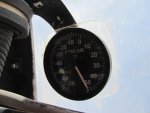PV=nRT The ideal gas law is only an approximation of how a gas will react under certain conditions, because there are no ideal gases. Gases in the real world don’t always obey.
I agree that all dry gases will behave in the same way. When enclosed in a fixed volume pressure will increase as temperature increases. But all gases will not experience the same amount of increased pressure.
If I filled liter bottles of argon, oxygen, nitrogen, helium, etc. at atmospheric pressure, then capped them put them in the sun with pressure gauges and observed. If I understood your point correctly they would all increase the same in pressure. I don’t think they would all increase the same.
If this thinking is flawed please help me to understand why I am wrong.
I really think the main point has been made here. If your optic is not built well enough to remain sealed under severe conditions buy better ones. And even good ones wear out over time.


